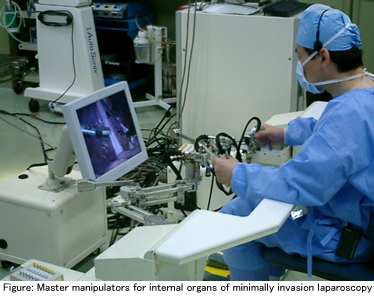 |
 |
|
|||||||||||||||||||||||||
|
| Development of Robots Safe for Surgery with Minimal Invasion |
Mamoru Mitsuishi, Prof., Industrial mechanical engineering, Graduate School Engineering course What I'm stressing on is the development of medical robots. As their merits, there are minimal invasion, germfree operation, low infection risk, stability and remote operation. There are some robots for use in minimally invasion laparoscopy operation, depth cerebral nerve surgery or artificial knee joint replacement operation. Besides we have robots to work for positioning legs precisely at thigh bone operation and recovering broken complicated scaphoideum bones. We've already build up those robots to be improved. Minimally invasion laparoscopy operation robot has three arms, two for forceps and one for laparoscopy. Operators give operations while viewing the monitors from laparoscopy. Presently the second robot is in production. Robots working for depth cerebral nerve surgery has a camera shooting affected area. When operators move manipulators while viewing displays, then slave manipulators move. The second model can put 0.1mm thick needle through 1mm thick blood tube, or can extract brain tumor(2X2cm) 8cm deep in the brain. Now we are redesigning it so that it can tighten forceps more. Those robots are hand-made by the students. We developing image transference for remote use, optical measurement and high speed precise processing system. My idea is that we commercialize those robot models within two years. To do it, we have documents approved by the health, labor and welfare ministry. Now Ministry of economy and industry and Ministry of health, labor and welfare are proceeding the guideline for examining of navigation operation(operation robot) . When those steps are set, then I hope we will be taking one step ahead. There is some proposals coming up from Washington University and some researchers for cooperation. For medical robots, the market is world-wide, so there must be standards needed for robots and their materials. |
Originally I went up to the department of science to study semi-conductor or chip, resulting in being kept from practical level. So I entered the engineering department. In fact I was interested in designing and assembling and found I was good for the field. At first I was studying machine tools when I happened to meet an old class mate from middle school. That happening had me change my study theme. He was an orthopedic surgeon at the hospital attached to Okayama University. He told me that he found it harder to connect blood tubes than nerves. His words hit me, thinking that there must be needs of robots working as precise and sensitive handlings. However, the field was totally new to me and there was less relationship between medical and engineering, so I had hard time with materials and designing. Eventually, I was successful of remote controlled operation to connect blood tubes 1mm in diameter. It was done between Tokyo University and Okayama University. I have begun giving presentations to some of medical societies. From my experiences I had, it's important to share discussions with people from various back grounds as well as from the same field of mine in order to choose theme for study and to further it. I learned many things from people from different fields when I attended the study circle supported by Professor Hatamura Yotaro famous for " Shippai-gaku ( learning from failure)" whose room was next to mine. The topics we shared were not only variety of knowledge but something that inspired me later on. I always comes up with ideas how to proceed my studies while taking a bath or standing on a train, or even right before getting up. I'm afraid to say, but I sometimes think about another thing and come up with an idea while talking with another person. I'd like to tell young students to move their hands rather than feel worried, Trial and error is never a waste as long as you keep building up something as an engineering researcher. |
 Master manipulators of the robot for minimally invasion laparoscopy operation. Operator handles arms to operate forceps and laparoscopy while viewing images from laparoscopy .The operator can not keep forceps still for some time but the robot can. With this equipment they succeeded extraction operation of a pig's gallbladder four times. |

<Personal Background> 1956:Born in Okayama. 86:Doctor of Eng. of Tokyo Univ. Lecturer and assistant prof. of eng. of Tokyo Univ. prof. of dep. of industry and mechanics. Researches computer integrated operation support system (long-distance operation system, long-distance diagnosis system), intellectualized productive system (censor information merged system), IT productive system, feeling transmittance long-distance education system. |
| <<Back | Page top |